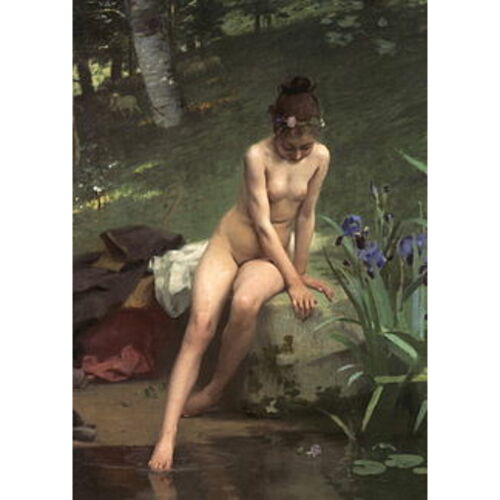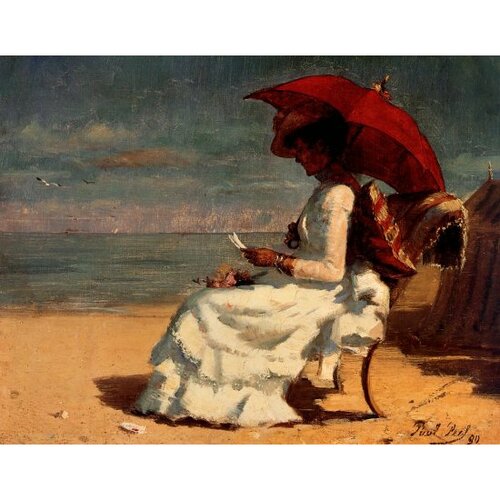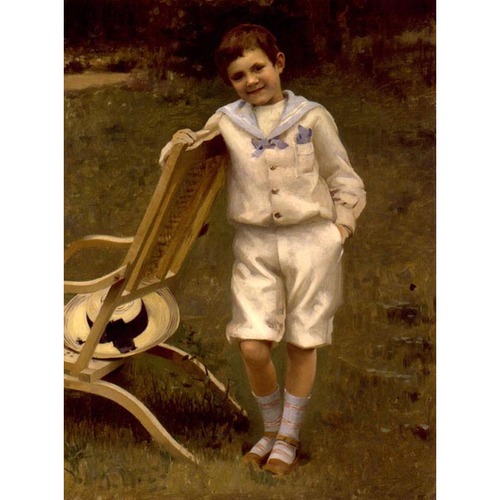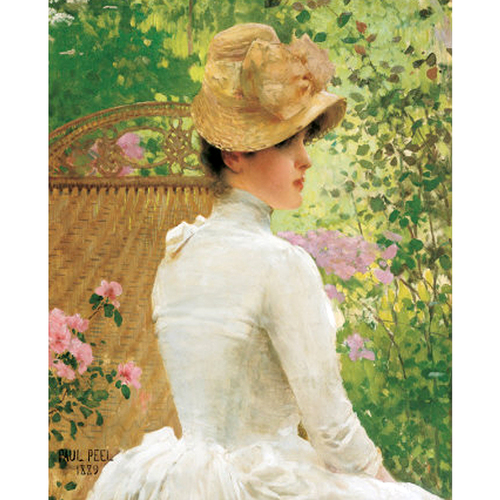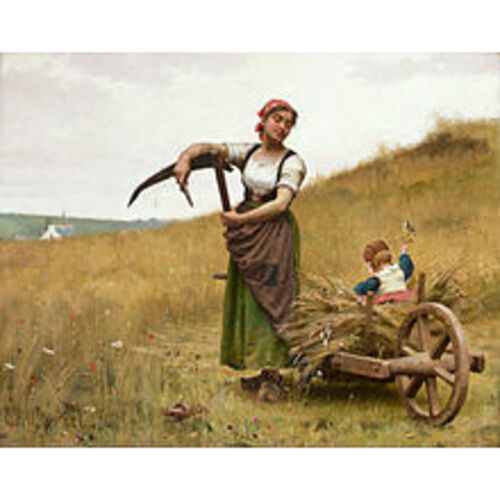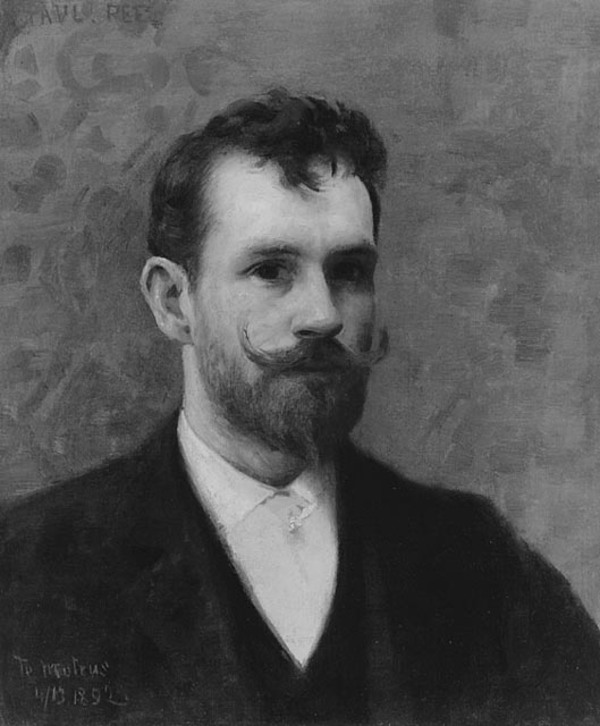
Source: Courtesy of Wikimedia Commons
PEEL, PAUL, painter; b. 7 Nov. 1860 in London, Upper Canada, son of John Robert Peel and Amelia Margaret Hall; m. 16 Jan. 1886 Isaure Fanchette Verdier in Willesden (London), England, and they had one son and one daughter; d. 3 Oct. 1892 in Paris.
In the early 1850s Paul Peel’s parents, both of whom were born in England, settled in London, Upper Canada, where his father quickly prospered as a stone-carver and drawing instructor. The eight Peel children were provided with a supportive and artistic family milieu; Paul and his sister Mildred especially flourished under their father’s tutelage. In 1875 Paul became a pupil of the English-born landscape and portrait painter William Lees Judson, who instructed him in the rudiments of the predominant style of the day, called academic art, and encouraged him to paint outdoors. One of Peel’s works dating from his two years under Judson won a prize at London’s Western Fair in September 1876.
The following summer Peel was accepted into the Pennsylvania Academy of Fine Arts, in Philadelphia, where he studied with Christian Schussele and the more progressive Thomas Eakins. Training consisted not only of drawing from engravings, plaster casts, and the live model, but also included the study of portraiture, still-life, perspective, and anatomy. Eakins instilled in the young artist a desire to explore the visual world intensely and to render it accurately using a new, direct method of painting which involved “drawing” immediately with the brush and coloured pigments. By April 1880 Peel was back home, greatly enriched.
Three prizes received at the Western Fair of 1880, as well as several sales, reflect the artist’s growing local reputation, although his paintings to this point – primarily genre scenes and landscapes – remained stilted and unresolved. In early October Peel was elected to membership in the Ontario Society of Artists [see John Arthur Fraser], and by the end of the month had departed for Europe, possibly stopping in London where he may have attended classes at the Royal Academy of Arts. Peel spent much of the next dozen years in Paris, attracted by its superior art schools and opportunities for exhibiting. In this regard he typifies the second wave of Canadian artists who studied and worked in France, including William Brymner*, George Agnew Reid*, and Robert Harris*.
The spring and summer of 1881 were passed at Pont-Aven, Brittany, a village especially favoured by Americans for its picturesque setting and the traditional life-style of its inhabitants. By June, Peel had already sent four paintings on Breton themes to his father, who had them included in the second annual exhibition of the Royal Canadian Academy of Arts [see John Douglas Sutherland Campbell*; Lucius Richard O’Brien], held in Halifax, and the Industrial Exhibition, Toronto. That fall Peel settled in Paris near the bohemian quarter of Montparnasse and began working on the first of his many large-scale genre paintings, The spinner. Its carefully planned yet confident verisimilitude marks a significant stage in the artist’s development. In April 1882 it was exhibited in Montreal by the RCA; in addition to furthering his reputation at home it was influential in securing his election that month as an associate of the academy. Also in April, in Paris, he began to study under Jean-Léon Gérôme, a leading exponent of the academic style, in his studio located in the École des Beaux-Arts, although contrary to tradition Peel was never officially enrolled at the École. Gérôme, not coincidentally, had taught Eakins, Peel’s teacher in Philadelphia. Peel’s large painting La première notion on the theme of mother and child, was accepted for inclusion in the 1883 Salon of the Société des Artistes Français, a remarkable achievement for a 22-year-old.
Peel spent the summer and fall of 1883 in London, Ont., where he completed several portraits and landscapes including the accomplished Covent Garden Market, London, Ontario. He exhibited works at the Industrial Exhibition and the Western Fair, winning no fewer than seven first prizes at the latter. On 13 December he and Mildred left for Paris and passed the following summer in Pont-Aven. The presence there of Jules Bastien-Lepage, a proponent of the juste milieu, a compromise between the academic style and Impressionism, encouraged Peel to paint more broadly and with a sunnier palette. He also met at Pont-Aven the Danish-born painter Isaure Fanchette Verdier, who became his wife on 16 Jan. 1886. In the spring they visited Isaure’s family in Copenhagen, where the following year Peel’s mother-in-law sold one of his paintings (Two friends, 1886) to Alexandra, Princess of Wales, while she was on a visit to her native city. After a trip to London, England, in May 1886 to view the Colonial and Indian Exhibition, where Peel had seven works displayed, the couple returned to Paris. Their first child, Robert André, was born there on 22 October. Émilie Marguerite was to follow on 15 Nov. 1888.
Peel exhibited a pastel in each of the Salons of 1887 and 1888 (both works are now lost), and continued his formal training. Beginning in 1887 he spent four years studying with Benjamin Constant, who influenced his awakening interest in exotic, foreign subjects. When Constant was hired in the fall of 1888 to teach at the Académie Julian, Peel followed him there and brought along his new Canadian friend, the recently arrived George Agnew Reid. They found a large, friendly coterie of young artists, including several other Canadians. Peel’s work from 1888 and 1889 demonstrates an assurance and sophistication not previously evident, especially in his painting of a new subject, the nude. His entries in the Salon of 1889, The Venetian bather and The modest model (the latter won an honourable mention) are attractively conceived and competently executed, particularly in the modelling of the human form.
Works by Peel were also included in Canadian exhibitions held in 1889: the RCA (Ottawa), the Art Association of Montreal, the OSA (Toronto), and the Industrial Exhibition. His growing reputation at home was acknowledged by his election on 26 April 1890 to full membership in the RCA. Peel’s greatest achievement, however, was the third-class medal he received from that year’s Salon for the impressive After the bath. Like several of his works, it evolved from a carefully composed photograph; this practice was recommended by Gérôme but Peel’s use of it has not yet been fully assessed. In part owing to favourable reviews, which were immediately forthcoming, several collectors, among them the actress Sarah Bernhardt, were attracted to this large painting. It finally sold in 1891 to the Hungarian government and today hangs in the Art Gallery of Ontario.
In July 1890 Peel made a trip home to see his dying mother. He did some oil sketching around southern Ontario and at Quebec in a light-filled Impressionist mode, and organized an exhibition of 32 of his works at London’s Tecumseh House Hotel towards the end of September. More important, he held an auction of 57 works in Toronto in mid October, a sale which realized $2,746. Although contemporaries generally felt that the paintings had sold for less than their true value, scholars continue to disagree about whether this amount constituted an adequate reward for Peel’s efforts, and no comment from the artist himself has survived. In November he left for France.
The next two years witnessed a further consolidation of Peel’s art and reputation. He spent the summers with his family in Denmark and continued to exhibit at the Salon (La jeunesse in 1891 and Les jumelles in 1892) as well as in Toronto. In late September 1892 he suddenly fell ill in Paris and died on 3 October, possibly of influenza.
Although Peel left a substantial body of work, he must be seen as a talented painter at the threshold of achieving his full artistic maturity. Despite a certain unevenness often found in the work of young artists, Peel’s creative output made him, in his day, perhaps Canada’s best-known painter in Europe. His frequent displays of technical virtuosity, especially in the depiction of the human body, his adherence to the conservative tenets of the juste milieu, and his fascination with domestic scenes of women and children – always touching, occasionally erotic – perfectly reflect 19th-century European bourgeois values and the artistic concerns of most of his generation. Peel’s considerable popularity in Canada today rests on a few pictures in just such a mode. However sentimental, they continue to strike immediate chords.
[Works by Paul Peel are held in a number of public collections, including the National Gallery of Canada (Ottawa), the Art Gallery of Ontario (Toronto), and the London Regional Art Gallery (London, Ont.).
The author gratefully acknowledges Victoria Baker’s exhibition catalogue Paul Peel: a retrospective, 1860–1892 (London, Ont., 1986), the most complete publication on Peel to date. Although extremely thorough in its presentation of factual information, and extensively illustrated, the catalogue falls short of properly establishing the North American and European artistic and social contexts for Peel’s career and hence of interpreting his works fully. Aleksa Čelebonović, The heyday of Salon painting: masterpieces of bourgeois realism (London, 1974), H. B. Weinberg, The American pupils of Jean-Léon Gérôme (Fort Worth, Tex., 1984), and Brain Dijkstra, Idols of perversity: fantasies of feminine evil in fin-de-siècle culture (New York, 1986) are but three publications which supplement the catalogue in this area. d.w.]
A.-P.-M. Dayot, Le Salon de 1890 (Paris, 1890), 38. Le Figaro (Paris), 30 April 1890. Globe, 3 Nov. 1892. London Free Press, 12 Oct. 1892. Times (London), 28 Oct. 1892. Albert Boime, The academy and French painting in the nineteenth century (London, 1971). David Sellin, Americans in Brittany and Normandy, 1860–1910 (Phoenix, Ariz., 1982). David Wistow, “19th century Paris and the Canadian artist,” Canadians in Paris, 1867–1914 ([Toronto], 1979), 4–11.
Cite This Article
David Wistow, “PEEL, PAUL,” in Dictionary of Canadian Biography, vol. 12, University of Toronto/Université Laval, 2003–, accessed December 12, 2025, https://www.biographi.ca/en/bio/peel_paul_12E.html.
The citation above shows the format for footnotes and endnotes according to the Chicago manual of style (16th edition). Information to be used in other citation formats:
| Permalink: | https://www.biographi.ca/en/bio/peel_paul_12E.html |
| Author of Article: | David Wistow |
| Title of Article: | PEEL, PAUL |
| Publication Name: | Dictionary of Canadian Biography, vol. 12 |
| Publisher: | University of Toronto/Université Laval |
| Year of publication: | 1990 |
| Year of revision: | 1990 |
| Access Date: | December 12, 2025 |


